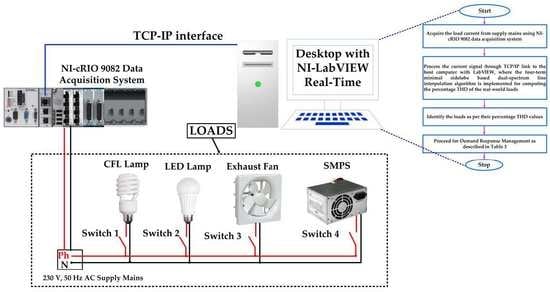Non-Intrusive Identification of Load Patterns in Smart Homes Using Percentage Total Harmonic Distortion
Abstract
1. Introduction
- Identification of load features;
- Load disaggregation;
- Developing insights into consumption behavior;
- Actionable recommendations.
1.1. Identification of Load Features
1.2. Load Disaggregation
1.3. Developing Insights on Consumption Behavior for Reducing Harmonic Pollution
1.4. Actionable Recommendations
1.5. Summary and Proposal
- The measurement of percentage THD using enhanced dual-spectrum line interpolated FFT (EDLIFFT) with a four-term minimal side-lobe window (4MSW) [37] for various real-world loads.
- The development of real-time load pattern identification for DR using a LabVIEW-based virtual instrumentation test bed.
- The recommendation of load patterns for DR management using a lookup table.
2. Measurement of Percentage THD, a Single Feature for Load Consumption Pattern Identification
- H = harmonic order
- In = nth harmonic current
- Ifund = fundamental current
3. Real-Time Experimentation for Non-Intrusive Identification of Load Pattern (NIILP) Using Percentage THD Measurement
4. Results and Discussion
5. Conclusions
Author Contributions
Funding
Acknowledgments
Conflicts of Interest
References
- Siano, P. Demand response and smart grids—A survey. Renew. Sustain. Energy Rev. 2014, 30, 461–478. [Google Scholar] [CrossRef]
- Du, P.; Lu, N.; Zhong, H. Demand Response in Smart Grids; Springer Nature: Cham, Switzerland, 2019. [Google Scholar]
- D’Hoop, G.; Deblecker, O.; Thomas, D. Power quality improvement of a microgrid with a demand-side-based energy management system. In Micro-Grids—Applications, Operation, Control and Protection; Intech Open: London, UK, 2019. [Google Scholar]
- Ruano, A.; Hernandez, A.; Ureña, J.; Ruano, M.; Garcia, J. NILM techniques for intelligent home energy management and ambient assisted living: A review. Energies 2019, 12, 2203. [Google Scholar] [CrossRef]
- Iksan, N.; Sembiring, J.; Haryanto, N.; Supangkat, S.H. Appliances identification method of non-intrusive load monitoring based on load signature of VI trajectory. In Proceedings of the 2015 International Conference on Information Technology Systems and Innovation (ICITSI), Bandung, Indonesia, 16–19 November 2015; IEEE: New Jersey, NJ, USA, 2015; pp. 1–6. [Google Scholar]
- Baptista, D.; Mostafa, S.S.; Pereira, L.; Sousa, L.; Morgado-Dias, F. Implementation strategy of convolution neural networks on field programmable gate arrays for appliance classification using the voltage and current (VI) trajectory. Energies 2018, 11, 2460. [Google Scholar] [CrossRef]
- Bouhouras, A.S.; Gkaidatzis, P.A.; Chatzisavvas, K.C.; Panagiotou, E.; Poulakis, N.; Christoforidis, G.C. Load signature formulation for non-intrusive load monitoring based on current measurements. Energies 2017, 10, 538. [Google Scholar] [CrossRef]
- Le, T.T.H.; Kim, H. Non-intrusive load monitoring based on novel transient signal in household appliances with low sampling rate. Energies 2018, 11, 3409. [Google Scholar] [CrossRef]
- Djordjevic, S.; Simic, M. Nonintrusive identification of residential appliances using harmonic analysis. Turk. J. Electr. Eng. Comput. Sci. 2018, 26, 780–791. [Google Scholar] [CrossRef]
- Đorđevic, S.D.; Dimitrijević, M.; Litovski, V. A non-intrusive identification of home appliances using active power and harmonic current. Facta Univ. Ser. Electron. Energetics 2016, 30, 199–208. [Google Scholar]
- Shi, X.; Ming, H.; Shakkottai, S.; Xie, L.; Yao, J. Nonintrusive load monitoring in residential households with low-resolution data. Appl. Energy 2019, 252, 113283. [Google Scholar] [CrossRef]
- Haq, A.U.; Jacobsen, H.A. Prospects of appliance-level load monitoring in off-the-shelf energy monitors: A technical review. Energies 2018, 11, 189. [Google Scholar] [CrossRef]
- Hart, G.W. Non-intrusive load monitoring. Proc. IEEE 1992, 80, 1870–1891. [Google Scholar] [CrossRef]
- Zoha, A.; Gluhak, A.; Imran, M.A.; Rajasegarar, S. Non-intrusive load monitoring approaches for disaggregated energy sensing: A survey. Sensors 2012, 12, 16838–16866. [Google Scholar] [CrossRef]
- Nalmpantis, C.; Vrakas, D. Machine learning approaches for non-intrusive load monitoring: From qualitative to quantitative comparation. Artif. Intell. Rev. 2019, 52, 217–243. [Google Scholar] [CrossRef]
- Chang, H.H. Non-intrusive demand monitoring and load identification for energy management systems based on transient feature analyses. Energies 2012, 5, 4569–4589. [Google Scholar] [CrossRef]
- Dimitrijević, M.; Stošović, M.A.; Stevanović, D. Classification of Nonlinear Loads using Current Spectrum. Power 2019, 1, 2. [Google Scholar]
- Zheng, Z.; Chen, H.; Luo, X. A supervised event-based non-intrusive load monitoring for non-linear appliances. Sustainability 2018, 10, 1001. [Google Scholar] [CrossRef]
- Çavdar, İ.H.; Faryad, V. New design of a supervised energy disaggregation model based on the deep neural network for a smart grid. Energies 2019, 12, 1217. [Google Scholar] [CrossRef]
- Fagiani, M.; Bonfigli, R.; Principi, E.; Squartini, S.; Mandolini, L. A non-intrusive load monitoring algorithm based on non-uniform sampling of power data and deep neural networks. Energies 2019, 12, 1371. [Google Scholar] [CrossRef]
- Wu, Q.; Wang, F. Concatenate convolutional neural networks for non-intrusive load monitoring across complex background. Energies 2019, 12, 1572. [Google Scholar] [CrossRef]
- Kim, J.G.; Lee, B. Appliance classification by power signal analysis based on multi-feature combination multi-layer LSTM. Energies 2019, 12, 2804. [Google Scholar] [CrossRef]
- Rafiq, H.; Shi, X.; Zhang, H.; Li, H.; Ochani, M.K. A Deep Recurrent Neural Network for Non-Intrusive Load Monitoring Based on Multi-Feature Input Space and Post-Processing. Energies 2020, 13, 2195. [Google Scholar] [CrossRef]
- Puente, C.; Palacios, R.; González-Arechavala, Y.; Sánchez-Úbeda, E.F. Non-Intrusive Load Monitoring (NILM) for Energy Disaggregation Using Soft Computing Techniques. Energies 2020, 13, 3117. [Google Scholar] [CrossRef]
- Sadeghianpourhamami, N.; Ruyssinck, J.; Deschrijver, D.; Dhaene, T.; Develder, C. Comprehensive feature selection for appliance classification in NILM. Energy Build. 2017, 151, 98–106. [Google Scholar] [CrossRef]
- Li, L.; Yang, L.; Chen, H.; Li, M.; Zhang, C. Multi-objective evolutionary algorithms applied to non-intrusive load monitoring. Electr. Power Syst. Res. 2019, 177, 105961. [Google Scholar] [CrossRef]
- de Souza, W.A.; Garcia, F.D.; Marafão, F.P.; Da Silva, L.C.P.; Simões, M.G. Load disaggregation using microscopic power features and pattern recognition. Energies 2019, 12, 2641. [Google Scholar] [CrossRef]
- Chui, K.T.; Lytras, M.D.; Visvizi, A. Energy sustainability in smart cities: Artificial intelligence, smart monitoring, and optimization of energy consumption. Energies 2018, 11, 2869. [Google Scholar] [CrossRef]
- Kelly, J.; Knottenbelt, W. Does disaggregated electricity feedback reduce domestic electricity consumption. A systematic review of the literature. arXiv 2016, arXiv:1605.00962. [Google Scholar]
- Zhuang, M.; Shahidehpour, M.; Li, Z. An overview of non-intrusive load monitoring: Approaches, business applications, and challenges. In Proceedings of the 2018 International Conference on Power System Technology (POWERCON), Guangzhou, China, 6–8 November 2018; IEEE: New Jersey, NJ, USA, 2018; pp. 4291–4299. [Google Scholar]
- Bouhouras, A.S.; Gkaidatzis, P.A.; Panagiotou, E.; Poulakis, N.; Christoforidis, G.C. A NILM algorithm with enhanced disaggregation scheme under harmonic current vectors. Energy Build. 2019, 183, 392–407. [Google Scholar] [CrossRef]
- Jimenez, Y.; Cortes, J.; Duarte, C.; Petit, J.; Carrillo, G. Non-intrusive discriminant analysis of loads based on power quality data. In Proceedings of the 2019 IEEE Workshop on Power Electronics and Power Quality Applications (PEPQA), Manizales, Colombia, 30–31 May 2019; pp. 1–5. [Google Scholar]
- Kang, H.; Kim, H. Household Appliance Classification using Lower Odd-Numbered Harmonics and the Bagging Decision Tree. IEEE Access 2020, 8, 55937–55952. [Google Scholar]
- Bouhouras, A.S.; Milioudis, A.N.; Labridis, D.P. Development of distinct load signatures for higher efficiency of NILM algorithms. Electric Power Syst. Res. 2014, 117, 163–171. [Google Scholar] [CrossRef]
- Available online: https://www.powergridindia.com/sites/default/files/footer/climate_change/Swachh_Power.pdf (accessed on 16 June 2019).
- Deepu, O.; Sindhu, T.K. Modeling of Nonlinear Loads and Analysis of Harmonics in a Small Scale IT Park. Resonance 2013, 100, 7. [Google Scholar]
- Varaprasad, O.V.S.R.; Sarma, D.V.S.S.S.; Paredes, H.K.M.; Simões, M.G. Enhanced Dual-Spectrum Line Interpolated FFT with Four-Term Minimal Sidelobe Cosine Window for Real-Time Harmonic Estimation in Synchrophasor Smart-Grid Technology. Electronics 2019, 8, 191. [Google Scholar]
- Varaprasad, O.V.S.R.; Sarma, D.V.S.S.S.; Panda, R.K. Advanced windowed interpolated FFT algorithms for harmonic analysis of electrical power system. In Proceedings of the 2014 Eighteenth National Power Systems Conference (NPSC), Guwahati, India, 18–20 December 2014; IEEE: New Jersey, NJ, USA, 2018; pp. 1–6. [Google Scholar]
- Khokhlov, V.; Meyer, J.; Grevener, A.; Busatto, T.; Rönnberg, S. Comparison of Measurement Methods for the Frequency Range 2–150 kHz (Supraharmonics) Based on the Present Standards Framework. IEEE Access 2020, 8, 77618–77630. [Google Scholar] [CrossRef]
- IEEE. Recommended practices and requirements for harmonic control in electric power systems. In IEEE Std 519-2014 (Revision of IEEE Std 519-1992); IEEE: New York, NY, USA, 2014. [Google Scholar]
- Available online: http://www.ni.com/pdf/manuals/376904a_03.pdf (accessed on 9 August 2018).
- Kelly, J.; Aldaiturriaga, E.; Ruiz-Minguela, P. Applying international power quality standards for current harmonic distortion to wave energy converters and verified device emulators. Energies 2019, 12, 3654. [Google Scholar] [CrossRef]
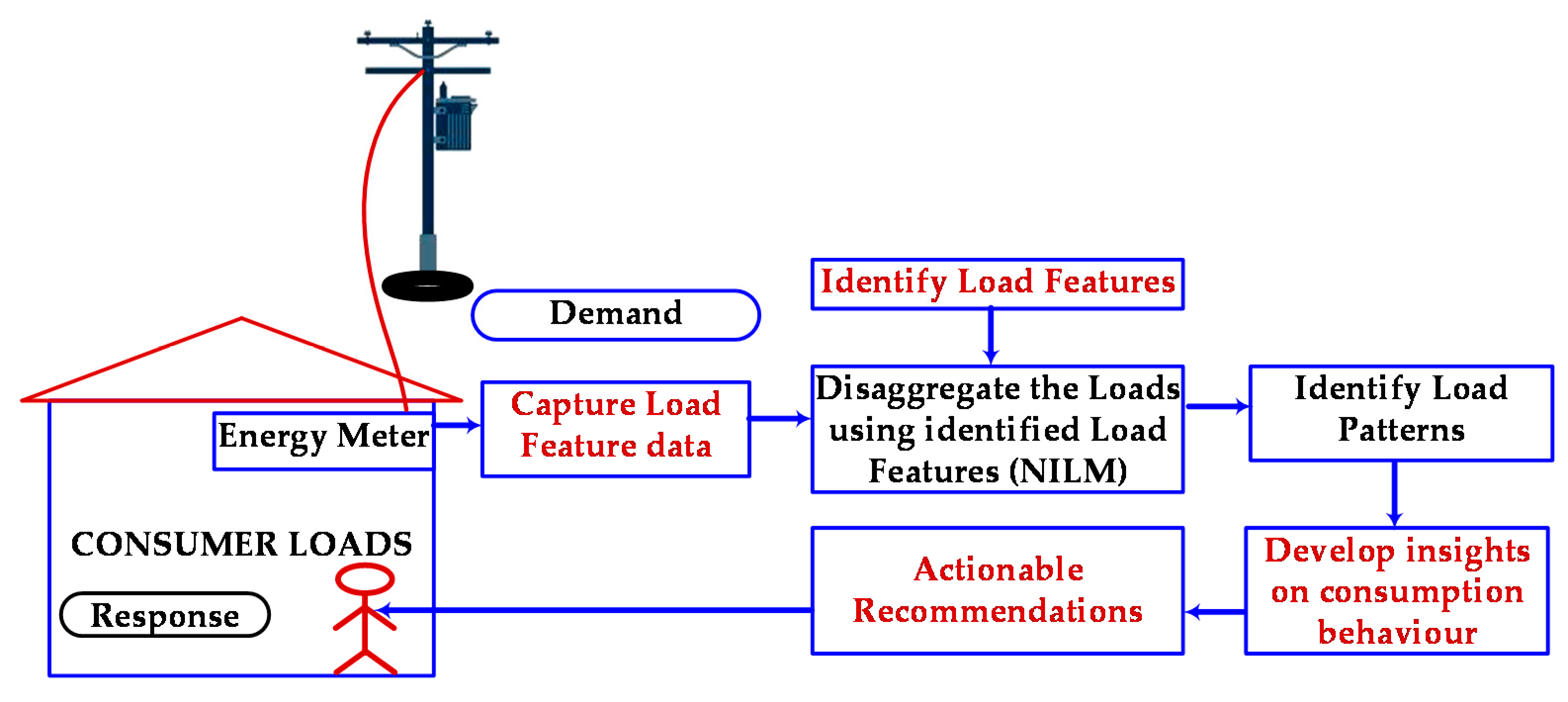
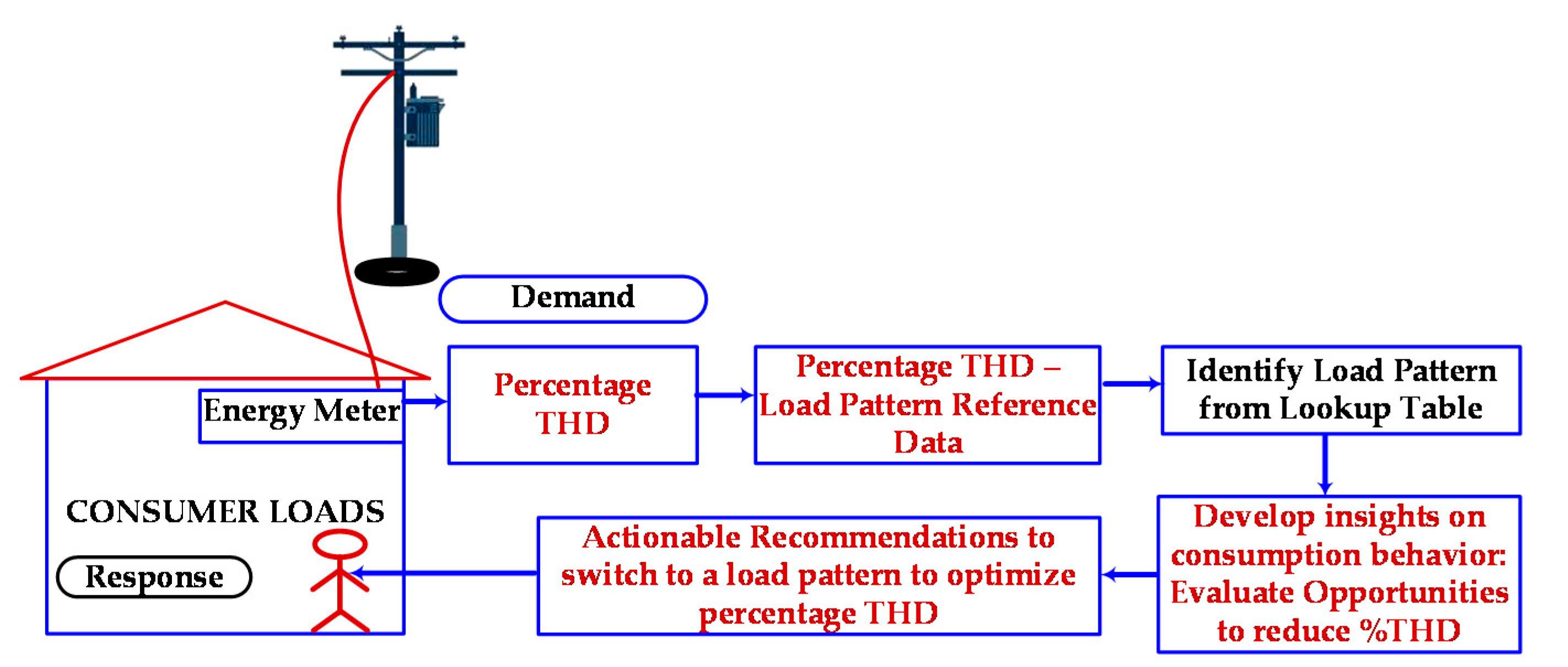
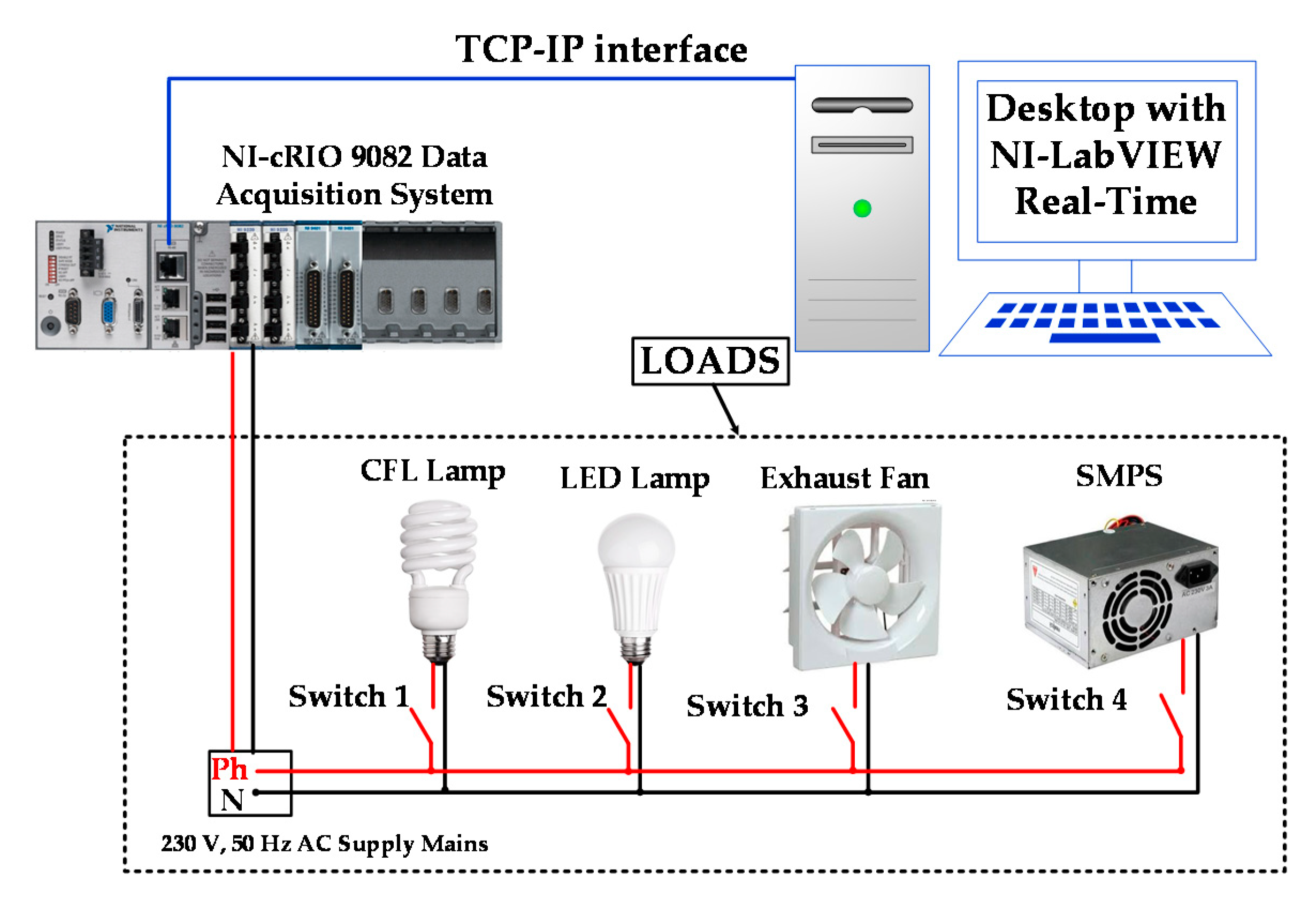
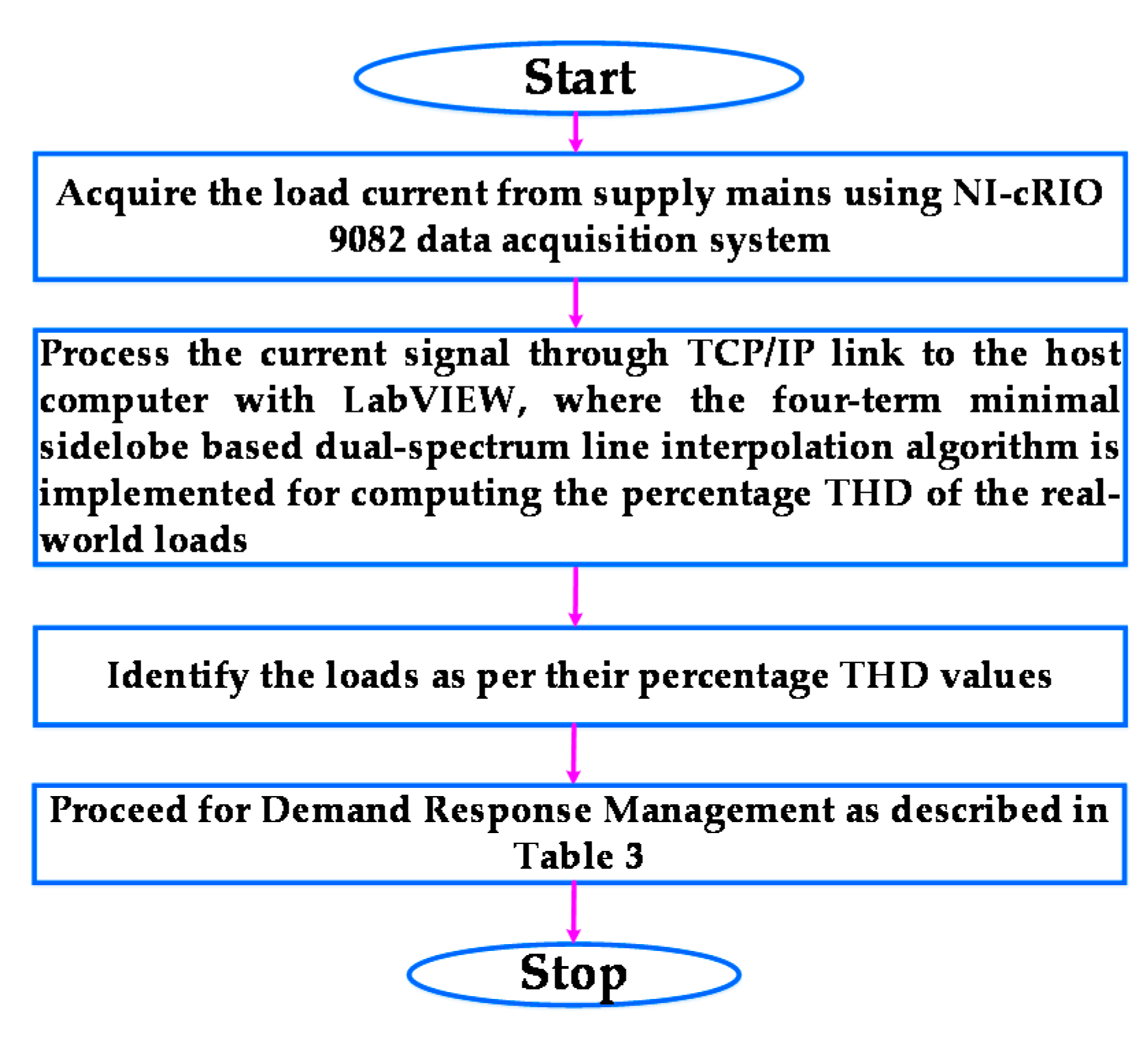

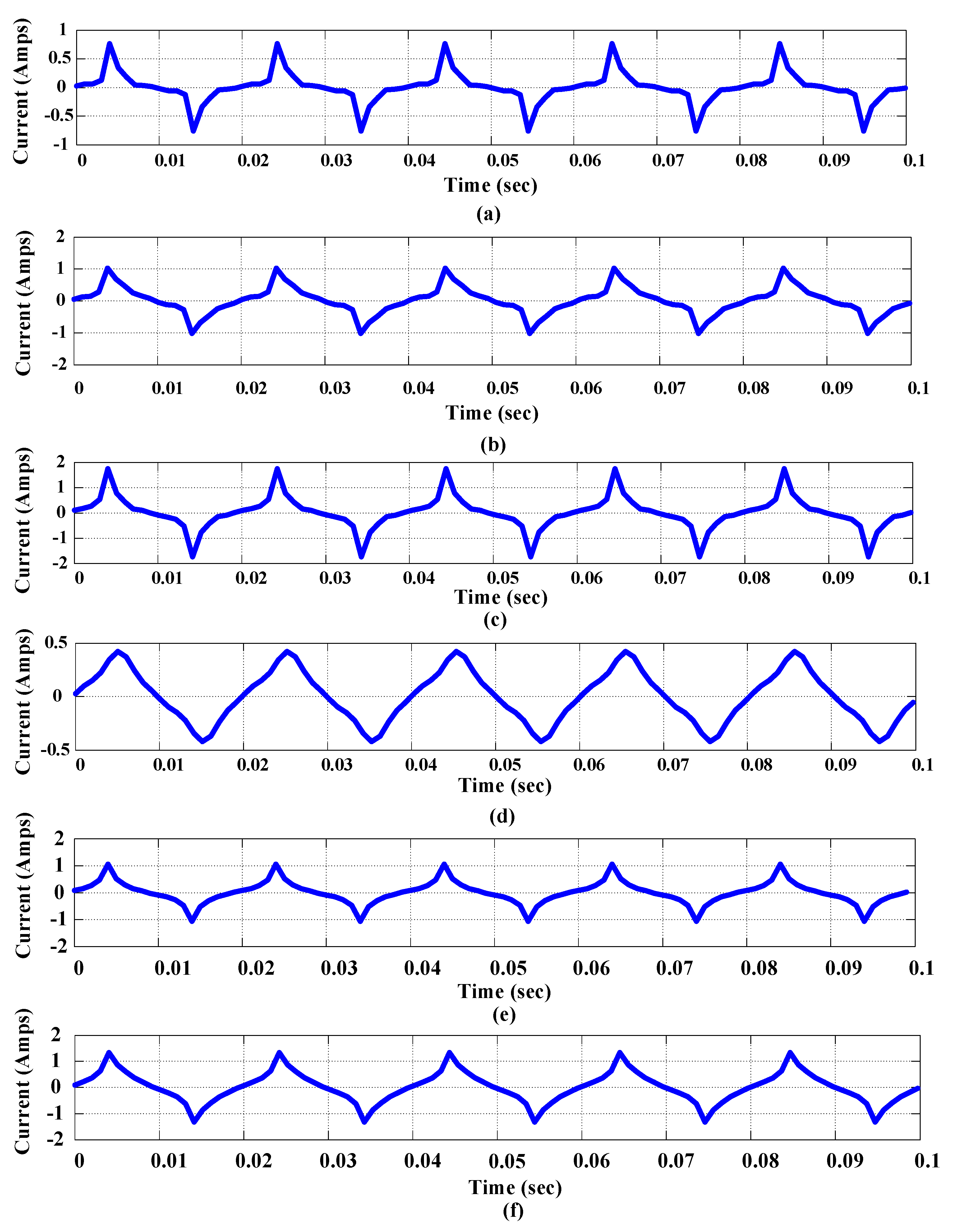
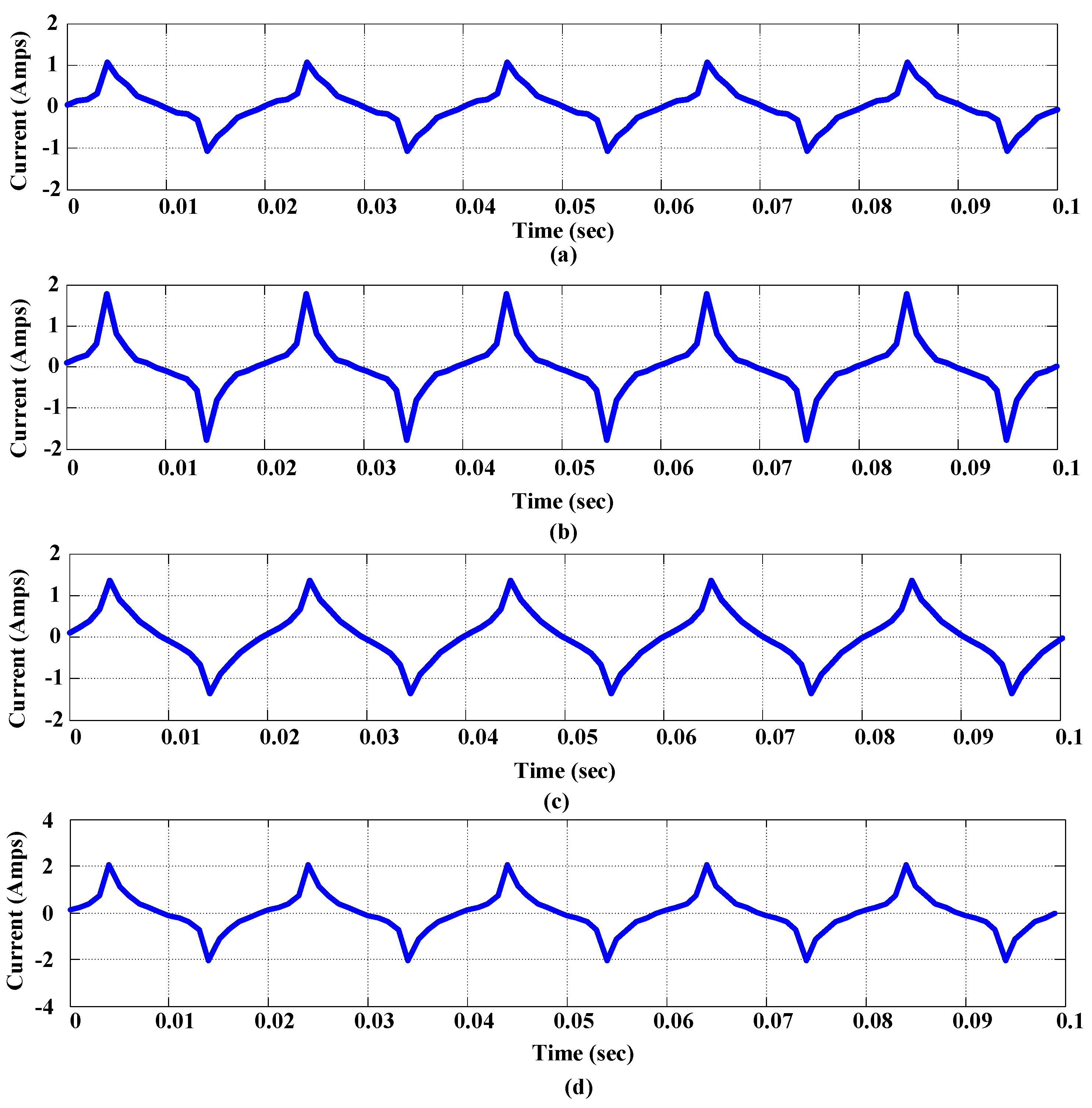

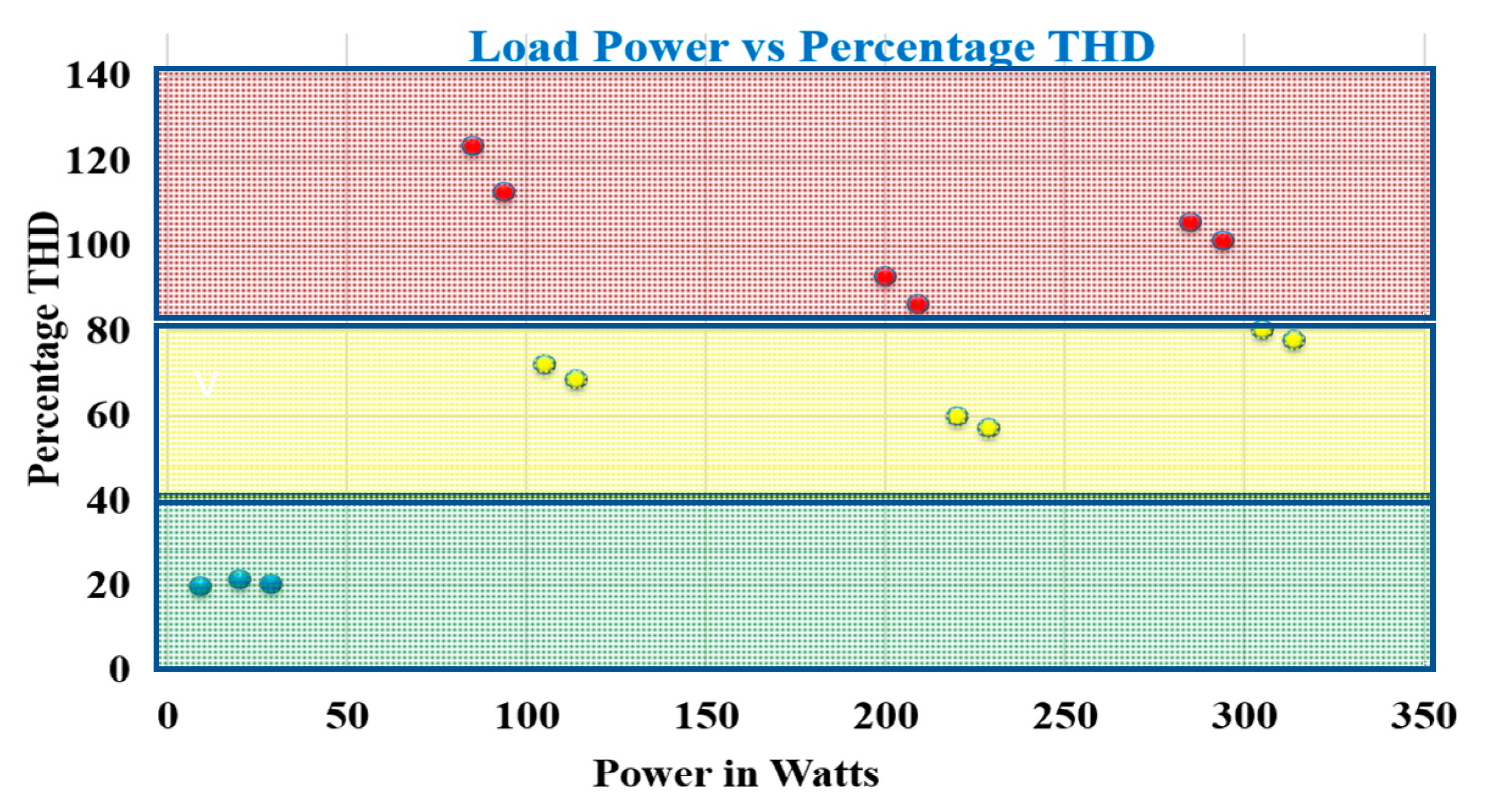
| Factor | Non-Experimental, Statistical Approach | Experimental Approach |
|---|---|---|
| Establishes | Correlations | Causation |
| Deals with | Aggregates, general understanding | Individuals, hence specific |
| Application | Understanding of macroscopic phenomena | Real-time measurement and micro-level control |
| Bias | Not easy to eliminate bias | Unbiased |
| Data | Approximations | Real data |
| Results | Probability, hence not conclusive | Exact, so conclusive |
| Regularity and repeatability | Mostly | Always |
| S.No | Combinations of Different Appliances | CODE | Power (Watts) | %THD |
|---|---|---|---|---|
| 1 | CFL | 1 0 0 0 | 85 | 123.395 |
| 2 | LED | 0 1 0 0 | 9 | 19.7279 |
| 3 | Exhaust Fan | 0 0 1 0 | 20 | 21.3272 |
| 4 | SMPS of PC | 0 0 0 1 | 200 | 92.763 |
| 5 | CFL + LED | 1 1 0 0 | 94 | 112.457 |
| 6 | CFL + Exhaust Fan | 1 0 1 0 | 105 | 72.007 |
| 7 | CFL+ SMPS of the PC | 1 0 0 1 | 285 | 105.402 |
| 8 | LED + Exhaust Fan | 0 1 1 0 | 29 | 20.3095 |
| 9 | LED + SMPS of the PC | 0 1 0 1 | 209 | 86.1947 |
| 10 | Exhaust FAN + SMPS of the PC | 0 0 1 1 | 220 | 59.6673 |
| 11 | CFL+ LED + Exhaust Fan | 1 1 1 0 | 114 | 68.3618 |
| 12 | CFL+ LED + SMPS of PC | 1 1 0 1 | 294 | 101.076 |
| 13 | LED + Exhaust Fan + SMPS of PC | 0 1 1 1 | 229 | 57.0561 |
| 14 | CFL+ Exhaust Fan + SMPS of PC | 1 0 1 1 | 305 | 80.1096 |
| 15 | CFL+ LED + Exhaust Fan + SMPS of PC | 1 1 1 1 | 314 | 77.6529 |
| Standard Deviation | 33.069 | |||
| Actionable Insights and Benefits | ||||||||||
|---|---|---|---|---|---|---|---|---|---|---|
| Demand | Response | Benefits | ||||||||
| S.No | CODE | Power | %THD | Actionable Insights | S.No | CODE | Power | %THD | Change in %THD | Change in Power |
| 1 | 1 0 0 0 | 85 | 123.395 | Turn off CFL | 2 | 0 1 0 0 | 9 | 19.7279 | −84.0124 | −89.4118 |
| 2 | 0 1 0 0 | 9 | 19.7279 | NR 1 | NR | 0 1 0 0 | 9 | 19.7279 | 0 | 0 |
| 3 | 0 0 1 0 | 20 | 21.3272 | NR | NR | 0 0 1 0 | 20 | 21.3272 | 0 | 0 |
| 4 | 0 0 0 1 | 200 | 92.763 | Turn off LED for daytime | 9 | 0 0 0 1 | 209 | 86.1947 | −7.08073 | 4.5 |
| 5 | 1 1 0 0 | 94 | 112.457 | Turn off CFL | 2 | 0 1 0 0 | 9 | 19.7279 | −82.4574 | −90.4255 |
| 6 | 1 0 1 0 | 105 | 72.007 | Turn off CFL | 8 | 0 1 1 0 | 29 | 20.3095 | −71.7951 | −72.381 |
| 7 | 1 0 0 1 | 285 | 105.402 | Turn off CFL for daytime | 4 | 0 0 0 1 | 200 | 92.763 | −11.9912 | −29.8246 |
| 8 | 0 1 1 0 | 29 | 20.3095 | Turn off LED for daytime | 3 | 0 0 1 0 | 20 | 21.3272 | 5.010955 | −31.0345 |
| 9 | 0 1 0 1 | 209 | 86.1947 | Turn off LED for daytime | - | 0 1 0 1 | 209 | 86.1947 | 0 | 0 |
| 10 | 0 0 1 1 | 220 | 59.6673 | NR | - | 0 0 1 1 | 220 | 59.6673 | 0 | 0 |
| 11 | 1 1 1 0 | 114 | 68.3618 | Turn off CFL | 8 | 0 1 1 0 | 29 | 20.3095 | −70.2912 | −74.5614 |
| 12 | 1 1 0 1 | 294 | 101.076 | Turn off CFL | 9 | 0 1 0 1 | 209 | 86.1947 | −14.7229 | −28.9116 |
| 13 | 0 1 1 1 | 229 | 57.0561 | Turn off LED for daytime | 10 | 0 0 1 0 | 220 | 59.6673 | 4.576548 | −3.93013 |
| 14 | 1 1 0 1 | 305 | 80.1096 | Turn off CFL | 13 | 0 1 1 1 | 229 | 57.0561 | −28.7774 | −24.918 |
| 15 | 1 1 1 1 | 314 | 77.6529 | Turn off CFL | 13 | 0 1 1 1 | 229 | 57.0561 | −26.5242 | −27.0701 |
| Quantitative Metric Category | Quantitative Metrics | %THD | Other NILM Methods |
|---|---|---|---|
| Feature selected | THD Sampling rate | Medium | High |
| Accuracy | Disaggregation percentage(D) | 100 | <100 |
| Disaggregation Error (DE) | 0 | >0 | |
| Precision(P)–TP 1/(TP + FP 2) | 1 | <1 | |
| Recall (R)-P/TP+FN | 1 | <1 | |
| Accuracy (Acc) = (TP + TN 3)/(TP+TN+FP+FN 4) | 1 | <1 | |
| F-measure (f1) 2 *P *R/(P + R) | 1 | <1 | |
| No training | User interaction | Low | |
| Real-time capabilities | Depends on algorithm’s computational complexity (computational cost) | Low | Low |
| Scalability | Algorithm computational complexity (simple algorithm scales better) | High | High |
| Identification factor | Standard deviation (FATσ) of %THD | 33.069 | NA |
| Generalization | Generalization over unseen houses | High | Medium |
© 2020 by the authors. Licensee MDPI, Basel, Switzerland. This article is an open access article distributed under the terms and conditions of the Creative Commons Attribution (CC BY) license (http://creativecommons.org/licenses/by/4.0/).
Share and Cite
Devarapalli, H.P.; Dhanikonda, V.S.S.S.S.; Gunturi, S.B. Non-Intrusive Identification of Load Patterns in Smart Homes Using Percentage Total Harmonic Distortion. Energies 2020, 13, 4628. https://doi.org/10.3390/en13184628
Devarapalli HP, Dhanikonda VSSSS, Gunturi SB. Non-Intrusive Identification of Load Patterns in Smart Homes Using Percentage Total Harmonic Distortion. Energies. 2020; 13(18):4628. https://doi.org/10.3390/en13184628
Chicago/Turabian StyleDevarapalli, Hari Prasad, V. S. S. Siva Sarma Dhanikonda, and Sitarama Brahmam Gunturi. 2020. "Non-Intrusive Identification of Load Patterns in Smart Homes Using Percentage Total Harmonic Distortion" Energies 13, no. 18: 4628. https://doi.org/10.3390/en13184628
APA StyleDevarapalli, H. P., Dhanikonda, V. S. S. S. S., & Gunturi, S. B. (2020). Non-Intrusive Identification of Load Patterns in Smart Homes Using Percentage Total Harmonic Distortion. Energies, 13(18), 4628. https://doi.org/10.3390/en13184628




